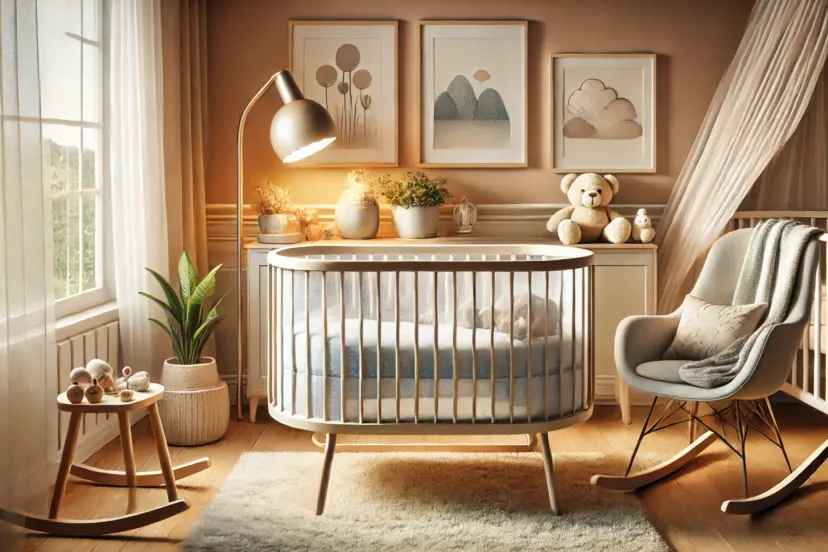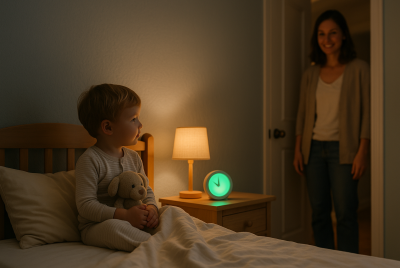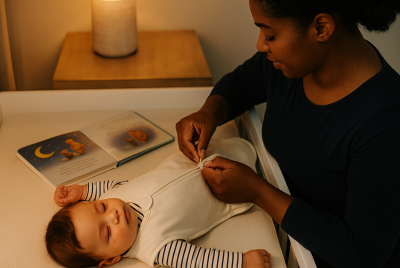Picking the Perfect Bassinet for Your Newborn
We may earn a commission for purchases made using our links. Please see our disclosure to learn more.
Hi there, new or soon-to-be parents! If you’re reading this, you’re undoubtedly overwhelmed by the variety of baby products available and wondering how such small people require so much things. I’ve been there, so believe me! Choosing where your newborn will sleep is one of the first major decisions you will have to make, and here is where the handy bassinet comes in. Like a pleasant coffee conversation, but without the caffeine (you’ll probably need to snooze whenever the baby does, anyhow), let’s explore everything you need to know about bassinets.
What’s a Bassinet, and Why Do You Need One?
Imagine that your newborn is up once more at three in the morning (for obvious reasons). Fortunately, their bassinet is just next to your bed, so it’s very easy to calm them down when they’re sleepy. A bassinet is a compact, comfortable bed designed specifically for infants. You won’t have to fumble around the home in the middle of the night because it’s small, portable, and keeps your infant close.
Newborns sleep a lot, but not for very lengthy periods of time. For the first few months, a bassinet is ideal since it allows children to sleep safely in their own room while still being close by. Additionally, it’s far cuter than placing them in a huge crib that they won’t even fit in at this point.
Why a Bassinet Beats the Couch or Your Bed
Let’s get real: co-sleeping sounds tempting, especially when you’re exhausted. But here’s the thing—sharing a bed can be risky for your little one. A bassinet gives them their own space, which the American Academy of Pediatrics (AAP) recommends for safe sleep. (And no, the couch is not an option—trust me, it’s a slippery slope.)
With a bassinet, your baby can snooze nearby without any risk of rolling over or getting tangled in bedding. Plus, it’s a total back-saver. You don’t have to bend over as much, and after weeks of carrying that baby belly, your spine will thank you.
Features to Look for in a Bassinet
Shopping for a bassinet can feel overwhelming. There are so many options out there that you’ll start dreaming about bassinets instead of the actual baby (been there!). Here’s the lowdown:
First, it needs to be sturdy. You want something that doesn’t wobble like an old dining chair. Look for breathable mesh sides, which are great for airflow and let you peek at your baby without leaning over too much. Portability is a lifesaver, especially if you want to move the bassinet around the house (sometimes, the kitchen is the quietest spot). Oh, and easy-to-clean fabric? Non-negotiable. Babies are adorable but messy—spit-up and blowouts don’t spare their sleeping space.
Types of Bassinets: Which One is Your Jam?
Bassinets come in all shapes and styles, kind of like coffee orders at Starbucks. There are traditional bassinets that look like something out of a Pinterest nursery. Co-sleeper bassinets are amazing if you want your baby right there but still in their own space.
Then there are rocking bassinets that gently sway your baby to sleep (it’s like magic until they decide rocking isn’t enough). And if you’re a techie, smart bassinets are a thing now! They play white noise, rock automatically, and some even track your baby’s sleep. It’s like having a personal assistant for naps.
How Long Can You Use a Bassinet?
This is a classic new-parent question, and the answer is: it depends. Most bassinets are designed for newborns up to 4–6 months or until they start rolling over. (Pro tip: once they’re doing that little push-up move during tummy time, it’s crib time.)
You’ll also want to keep an eye on the weight limit. Check the manual because every bassinet has its own threshold. Ignoring it is like stuffing too much luggage into an overhead bin—it’s just not safe.
Safety First, Always
Okay, safety might not be the most thrilling topic, but it’s the most important. Always place your baby on their back to sleep—none of those adorable tummy snoozes you see in old movies. The bassinet should be empty except for your baby. That means no pillows, blankets, or stuffed animals (I know, it feels a little bare, but it’s safer this way).
Also, make sure the bassinet is on a flat surface and away from things like curtains or cords. Babies are curious, even when they can barely move, and safety hazards are lurking everywhere.
Making the Move from Bassinet to Crib
Let’s talk transitions. Moving your baby to a crib might feel like a big step (for both of you). Start small—use the crib for naps before making it their nighttime spot. Keeping the same bedtime routine helps too. Whether it’s a lullaby, a quick cuddle, or that sound machine they’re obsessed with, familiarity is key.
Be patient with yourself and your baby. It’s a process, and like most parenting milestones, it’ll come with some trial and error.
Where Should You Put the Bassinet?
During those early months, having the bassinet in your bedroom is the way to go. It keeps your baby close and makes nighttime wake-ups less daunting. Pick a spot that’s flat, stable, and hazard-free. Trust me, you’ll want it within arm’s reach but not so close that you trip over it during your 2 a.m. bathroom runs.
Cleaning and Maintenance (Because Babies Are Messy!)
Let’s not sugarcoat it—babies are messy little humans. That cute bassinet you picked out? It’s going to see its fair share of spit-up and diaper blowouts. Make cleaning a regular part of your routine. Wash the sheets and removable fabric covers weekly or whenever they get dirty (which, let’s be real, will be often).
Check the frame and screws regularly too. Loose parts can be a safety hazard, and you’ll sleep better knowing everything is in tip-top shape.
Stylish Bassinets That Won’t Ruin Your Vibe
Who says baby gear has to be boring? There are so many chic bassinets out there now, you might actually want to show them off. Think minimalist designs with wooden accents or neutral tones that blend seamlessly with your decor. (Honestly, some bassinets look better than my furniture.)
If you’re into tech, there are bassinets that could pass for sci-fi gadgets, complete with motion sensors and white noise. Functional and fabulous—it’s a win-win.
Scientific Insights on Safe Infant Sleep Practices
Research has highlighted the importance of safe sleep environments for newborns, with bassinets playing a key role. A randomized trial titled “Wahakura Versus Bassinet for Safe Infant Sleep” compared traditional bassinets with the wahakura, an indigenous sleep device, and found both options to be similarly safe, emphasizing proper usage and adherence to safe sleep guidelines. Additionally, a comprehensive study on safe infant sleep practices, “Prevalence and Factors Associated With Safe Infant Sleep Practices”, revealed gaps in awareness, noting that only 42.4% of parents avoided soft bedding, and just 31.8% used approved sleep surfaces. These findings underscore the need for increased education to ensure safer sleeping conditions for infants.
Popular Bassinet Accessories and Essentials
When setting up your bassinet, a few thoughtful accessories can make a world of difference for your baby’s comfort and your convenience. Here are some popular items you can find on Amazon to complement your bassinet setup:
Halo Bassinest Fitted Sheet
This fitted sheet is designed specifically for the Halo Bassinest and features a soft, breathable material that ensures your baby stays cozy while sleeping. Its snug fit keeps the surface smooth and secure, adhering to safe sleep guidelines.
Little Giraffe Luxe Baby Blanket
Perfect for supervised cuddle sessions, this plush blanket adds a touch of luxury to your baby’s space. Made with ultra-soft fabric, it provides warmth and comfort for your little one during daytime snuggles (though remember, no blankets in the bassinet during sleep!).
Dream On Me Foam Mattress for Bassinets
If you’re looking to upgrade your bassinet mattress, the Dream On Me Foam Mattress is a great option. It offers extra firmness for safety while ensuring your baby’s comfort throughout their rest.
Munchkin Warm Glow Wipe Warmer
While not specifically for bassinets, this wipe warmer is a must-have for late-night diaper changes. The soft glow of the warmer provides enough light to navigate without disturbing your baby’s sleep.
Final Thoughts: Why a Bassinet is a Game-Changer
At the end of the day, a bassinet is more than just a place for your baby to sleep. It’s your middle-of-the-night lifesaver, your “keep them close” solution, and the first little bed your baby will ever have. It’s such a short phase of their life, but it’s a meaningful one.
You don’t need the fanciest bassinet on the market, just one that’s safe and works for your family. Because let’s face it: at 3 a.m., it won’t matter if it’s the latest model or the simplest design. As long as your baby is cozy and close, you’re doing an amazing job.
FAQs About Bassinets
1. How much does a bassinet cost?
They range from around $50 to $500, depending on the features. It’s easy to find one that fits your budget without sacrificing safety.
2. Are bassinets safe for overnight sleep?
Absolutely, as long as they meet safety standards and you follow the guidelines (like keeping it empty and placing your baby on their back).
3. Can I use a bassinet for twins?
Yep! Some bassinets are specifically designed for twins, or you can use two separate ones.
4. Do bassinets need assembly?
Most do, but it’s usually pretty straightforward. If I can do it on three hours of sleep, so can you.
5. What’s the difference between a bassinet and a cradle?
Cradles are bigger and often rock side to side, while bassinets are smaller, lighter, and easier to move around.
Now go forth and pick the perfect bassinet for your baby. You’ve got this, and if you’re still unsure, don’t sweat it—parenting is all about figuring it out as you go.




